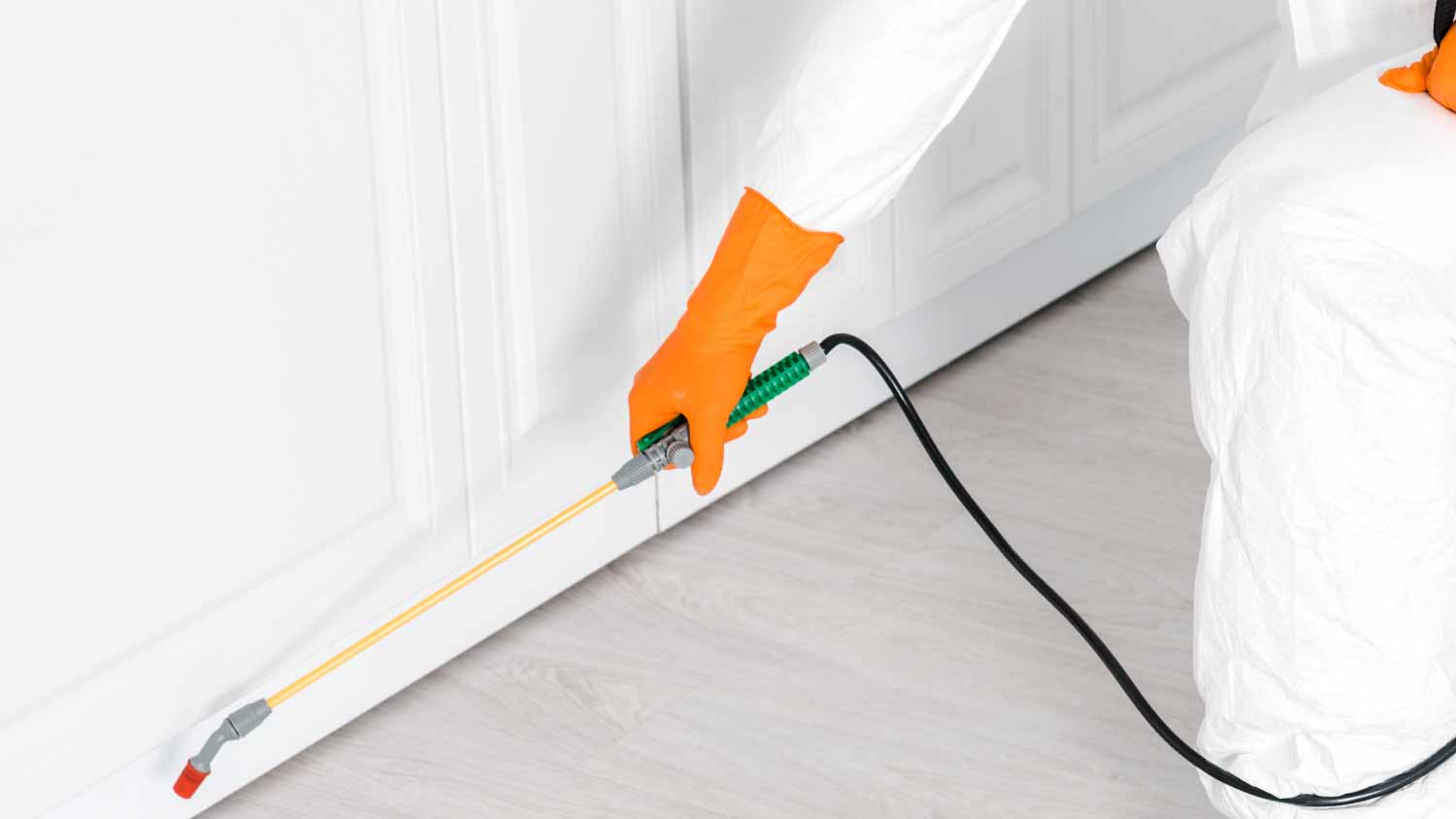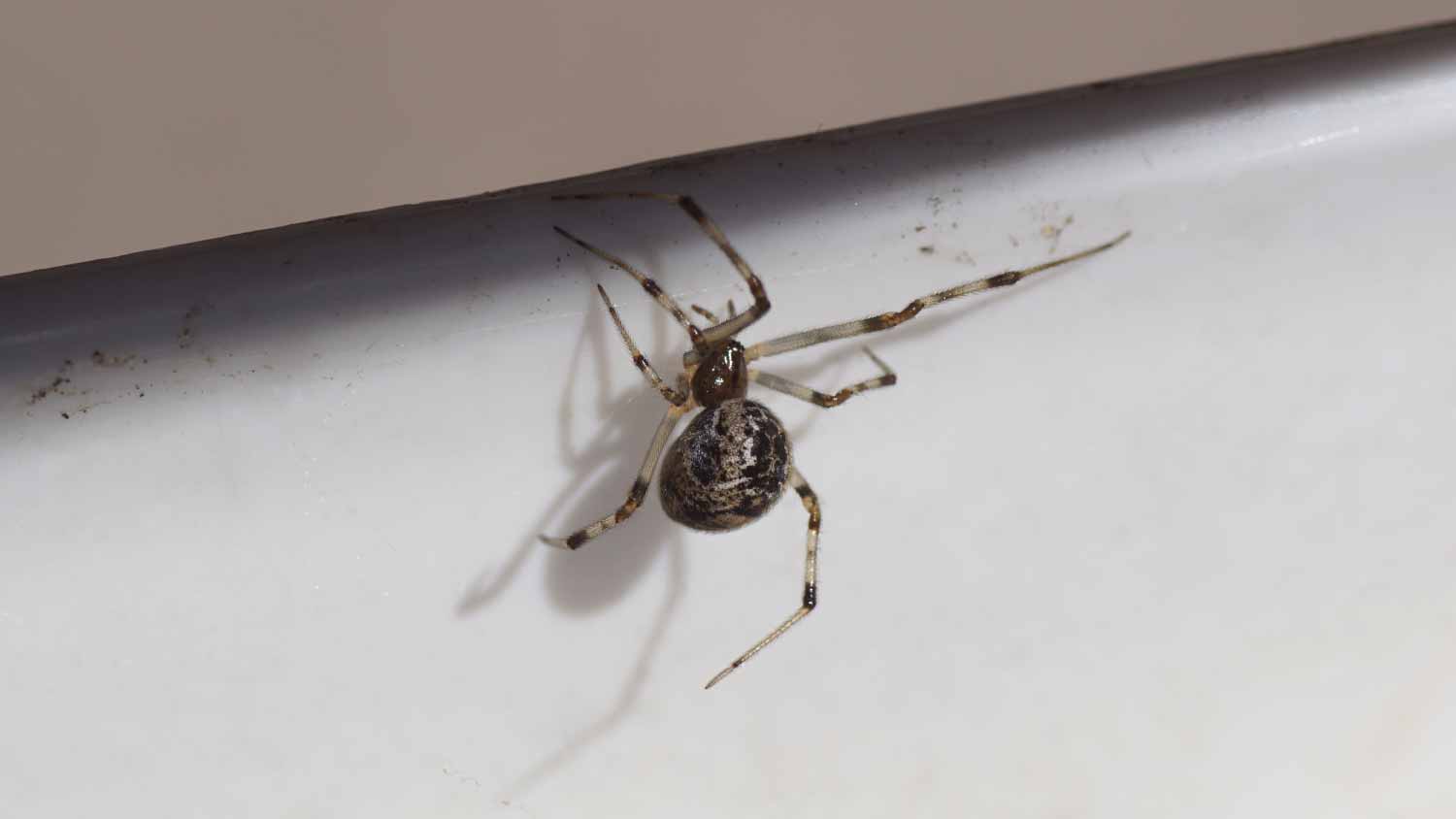
Whether you have bugs, bats, or rodents invading your home, you’ll want to contact an exterminator quickly. Find out how much pest control costs in Columbus, OH.
When too many legs means too much trouble


Most spiders are harmless or beneficial, and don’t infest a home like other pests.
It’s time to take action when multiple egg sacs hatch or when particularly venomous spiders start swarming indoors.
A vacuum cleaner and some insect spray can take care of many spider problems, but homeowners should call an exterminator to deal with an outbreak of especially venomous species like confirmed brown recluse or black widow sightings around the home.
Hire professionals to tackle large spider problems in areas like crawlspaces, dark attics, and sheds or eaves.
Pest control pros can offer solutions to keep spiders away and fix issues like cracks or gaps where they may be getting inside.
Seeing a spider or two around your home is common and rarely a problem. However, some spiders can cause big problems, especially if you start seeing a lot of them, so it’s essential to know when to call an exterminator for spiders.
Once you’ve gotten over the ick factor, when do you know that spiders have become a serious problem—one large enough to call in the professionals? Let’s review the top signs that it’s time to reach out to pest control professionals to handle your eight-legged problem.
Seeing one or two small spiders around your home isn't a cause for concern, but if you notice a large number of spiders or dangerous varieties, it's time to call a professional exterminator. Don't hesitate to take pest control action to prevent the infestation from growing.

Spotting a spider or two inside your home is not a cause for concern. Many spiders are excellent at hitching a ride indoors or finding a crack to slip through into dark indoor spaces. Most spiders are harmless and you shouldn’t kill them because many perform important pest control tasks, nabbing mosquitoes and flies before they can cause trouble.
However, sometimes homeowners need to intervene and clear out a major spider infestation before things get worse. Turn to an exterminator when you see these signs:
Hundreds of spiders that recently hatched
Venomous spider species that are dangerous to handle
Spider breakouts in areas of your home that are difficult to access
Spider problems caused by gaps, holes, or other home issues
Let’s take a closer look at the factors to keep in mind when deciding whether to contact pest control for spiders.
Spiders are born from egg sacs that hold up to 100 spiderlings, which immediately move out to look for new surroundings. If you suddenly see many spiders crawling along corners and walls, they could have recently hatched. That’s a sign you should contact an exterminator to address the current problem and look for more egg sacs.
Likewise, you may start seeing a lot of dead spiders curled up in the corners or recesses of the house. That’s a sign many spiders have recently come indoors, possibly to lay eggs, and warrants a closer inspection. If possible, try to find a dead spider or carefully approach a live spider and take a close-up photo of it. This evidence helps the pros identify what type of spider you’re dealing with and the best course of action to remove them.
Good news! Most spider species that wind up in your home don’t pose a threat to humans. Many harmless spider varieties don’t spread disease or cause property damage like many pests, such as termites. However, a few species pose more serious problems:
Black widow spiders: Black widows are infamous for their red hourglass markings, a warning sign on the larger females. The black widow spider’s venom is rarely dangerous, but you still want to keep them away from your home, especially from babies and pets. One black widow may not be a problem, but if you start seeing multiple widows, it’s time to call in an exterminator.
Brown recluse spiders: Brown recluses tend to stay out of sight, but they are one of the most venomous spiders in North America, known for their corrosive bites. They can be hard to spot, as small brown spiders with a violin-like marking on their backs, leading to the name “Fiddleback spider.” Confirming a brown recluse in your home is one of the best reasons to arrange for a full pest control inspection.
Yellow sac spiders: Noted for their yellow abdomens, these spiders have painful, venomous bites that humans should try to avoid. That can be difficult with an infestation, as yellow sac spiders are notoriously aggressive against people and pets alike. If they start moving inside, it’s time to contact the pros.
American house spiders: With bites similar to a bee sting, American house spiders pose a mild threat, but as their name suggests, they love the cozy indoors. If they start moving inside in large numbers, it’s time to take action. These spiders have longer, skinny legs with a mottled orange and black appearance.
The most dangerous spider species are strictly limited by climate and region, which changes the priority of calling for a professional. For example, black widow spiders are primarily located in the Southern United States and rarely cause trouble in frigid Northern states above Illinois. Brown recluse species are located almost entirely in the Southeast with a couple of types found in the lower Southwest states.
If you don’t live in an area where dangerous spiders are common, the urgency of hiring a professional for safety’s sake decreases. However, if a dangerous species is widespread in your area, finding professional help is more urgent. Keep in mind that you should hire a pro to inspect and remove a large spider infestation regardless of your home’s region.
The time of year can influence spider numbers and behavior. Be wary of early- and mid-spring when egg sacs laid before the cold months start hatching and create serious infestations. As late spring and summer arrive, some spider populations may increase and start causing problems. In the right climate, you may start seeing hundreds of orbweavers in your gutters and eaves.
That’s a few too many spiders for most homeowners, even if they’re outdoors.
Otherwise, spiders typically congregate where there’s plenty of food. If certain times of year yield lots of gnats, flies, or mosquitos near your home, you could see a big influx of spiders visiting, too.
If you spot telltale fuzzy egg sacs in the corners of your garage, basements, attic, or other spots, it’s time to consider hiring an exterminator for an inspection. One spider egg sac is a common find and you can get rid of them with care, but seeing them in multiple locations indicates there are many more hidden, waiting to hatch in the warmer months.
While cleaning cobwebs is an easy home task, seeing lots and lots of cobwebs could mean your home is a popular spot with spiders. Many webs means more chances that egg sacs are (or will be) nestled in the corners, too.
Some spiderweb or cobweb locations are easy to tackle with a broom or vacuum cleaner, even if there are lots of spiders. But for some locations, homeowners may prefer to call an exterminator. That’s a common call for dark sheds, crawlspaces, attics, and other spooky areas where homeowners would just as soon avoid. The exterminator pros and their protective equipment may be a better choice for dealing with spider infestations in these areas of your home.
If you locate many spiders near cracks or gaps (such as in a basement, attic, or vent), it’s time to call in pest control. The spiders are only a symptom of the problem, which is a space that’s letting pests in and needs filling in. The pest control pros can provide an inspection for other pests that may have entered, lay bait traps, and fix the issue.

A local spider control professional will use dedicated barrier sprays and pesticides to get rid of current spiders and keep them away. Traps, bait, and bug bombs are rarely needed for spider eradication, but exterminators may be able to suggest practices to help keep your home spider free.
An exterminator visit costs between $100 and $260. However, since spider removal can involve more targeted work and dealing with venomous insects, costs for spider pest control range from $100 to $500 or more. When getting quotes from multiple spider control services, be sure to specify the type of spider and infestation severity, if possible, for more accurate pricing.
You can make a final decision on whether to hire a pro or tackle spiders as a DIY project based on the type of spider, infestation severity, and location in your home. DIY removal with a vacuum and a ceiling duster saves money and is an easy solution for small problems, like a few spiders in the corners.
However, you should hire a spider exterminator if you have dozens of spiders in your home. It’s better to get the help of pros than trying to use so much pesticide yourself. Always try to trap and identify the spider species before making a call. Significant numbers of venomous spiders (especially brown recluses) are best left to pest control companies with protective equipment and experience.
From average costs to expert advice, get all the answers you need to get your job done.

Whether you have bugs, bats, or rodents invading your home, you’ll want to contact an exterminator quickly. Find out how much pest control costs in Columbus, OH.

It’s important to know bed bug treatment costs if you have an infestation. Our guide covers different treatment methods and cost factors to eliminate these pests.

Discover mosquito control service cost estimates, including average prices, key cost factors, and tips to save on professional mosquito treatments for your home.

Learn the 12 signs of termites to determine if your home has a termite infestation. Identify the signs early to prevent damage and reduce extermination costs.

Bed bugs are infamous for sticking around. Calling a bed bug removal pro is the best way to solve this problem for good: Here’s who to contact.

There's no one simple trick for getting rid of fleas in your house. But when you come at them from all angles, it's easy to send fleas packing for good.